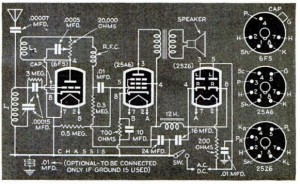
 This young woman is getting ready to tune in a favorite program, thanks to the radio designed to look like a book, described in the January 1940 issue of Popular Science. The design was intended to “appeal to all builders who prefer housing their receivers in some unusual type of cabinet.” It was perfect for the library table, where it would make an attractive decoration while pulling in the local stations.
This young woman is getting ready to tune in a favorite program, thanks to the radio designed to look like a book, described in the January 1940 issue of Popular Science. The design was intended to “appeal to all builders who prefer housing their receivers in some unusual type of cabinet.” It was perfect for the library table, where it would make an attractive decoration while pulling in the local stations.
The cabinet was constructed with the covers of a scrapbook purchased for less than a dollar. The jigsawed decoration on the cover was retained, and sides were build from matching wood. The circuit itself was a two-tube regenerative receiver. It ran directly off line current, with the filaments voltage provided by a “curtain burner” cord.
For those seeking a compact but more conventional design, the same issue of the magazine showed the design at right. It was a three-tube regenerative set featuring a small two inch speaker. Like the book radio, it covered the broadcast band. It was also an AC-DC set, with the filaments in series powered by the ubiquitous curtain burner.
showed the design at right. It was a three-tube regenerative set featuring a small two inch speaker. Like the book radio, it covered the broadcast band. It was also an AC-DC set, with the filaments in series powered by the ubiquitous curtain burner.


